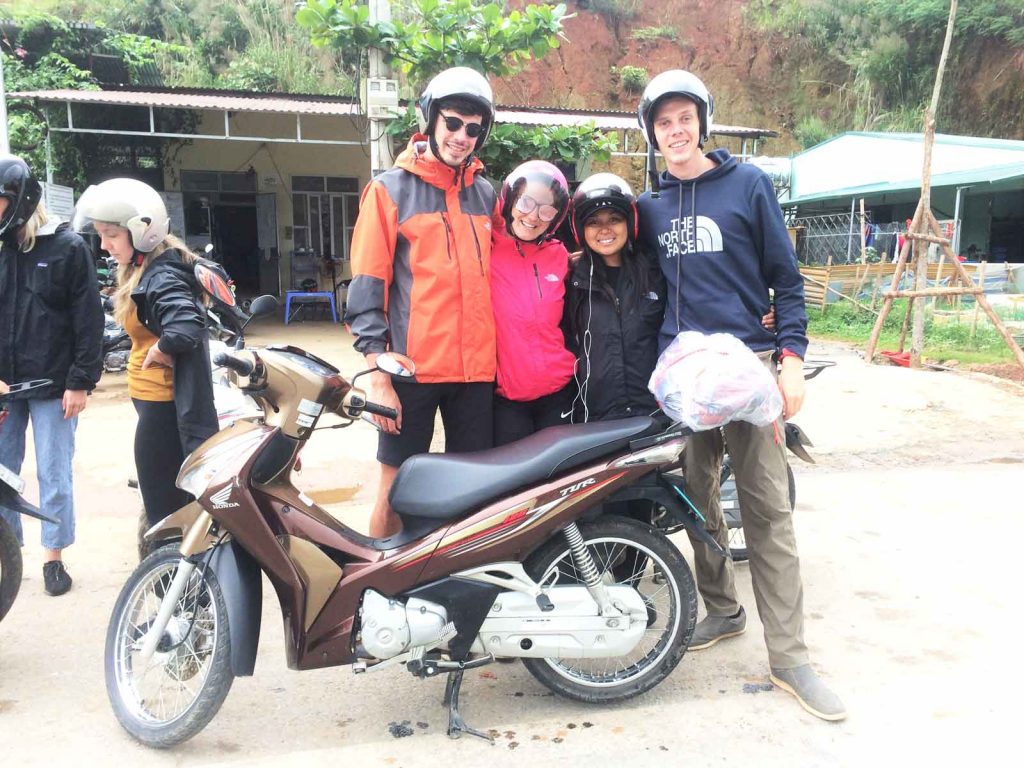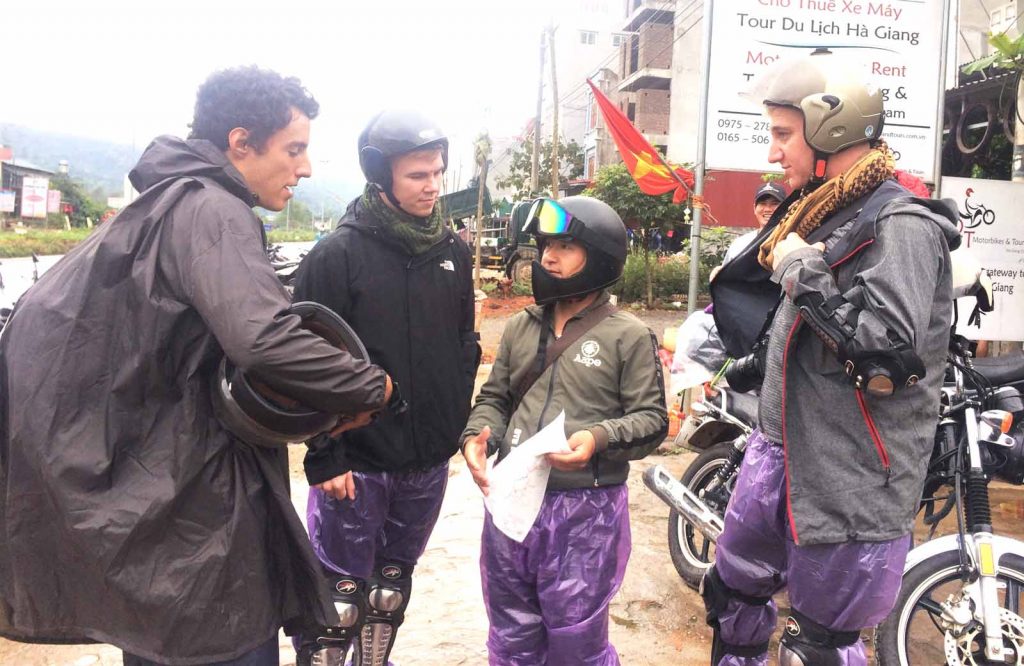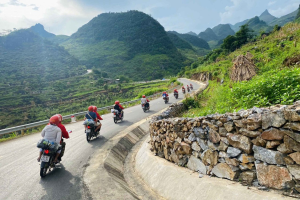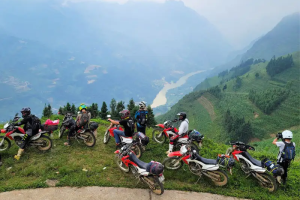Whether driving on your own, on a tour, or riding in the back of a local guide/driver, you might want to know What to pack for a ride along the Ha Giang Loop.
First of all, you need to know that you’ll be riding for about 4-5 hours a day at an average speed of 30-40 kilometers per hour. This means you’ll want to be as comfortable as possible. And you’ll want to avoid all extra weight. Here you’ll find my personal recommendations on what to pack for a ride along the Ha Giang Loop.

The question of what to pack for a ride along the Ha Giang Loop is usually connected to another very common one: what’s the weather like in the Ha Giang Loop? And as I tell you in that other post, the weather up in the mountains and valleys of Ha Giang change constantly. And that means it’s a bit difficult to decide what to pack for the ride

But whether you decide to venture on the Ha Giang Loop on your own or on a guided tour with other travelers, or to travel in the pillion of one of QT’s experienced drivers, you’ll spend a lot of time on a bike. What is more, some of the roads are a little bumpy at times. And the weather’s very changeable, to say the least. More importantly, you don’t want to carry extra weight on the bike. Because traveling as light as possible will definitely make your trip a more enjoyable experience.
So, first things first. There are two relevant things you need to know before venturing on the road:
- You can leave part of your luggage at QT for free. Either at QT garage or at QT Guesthouse, you can leave your stuff for free if you rent your motorbike or book a tour. The entire QT family will be more than happy to take care of your belongings until your trip is over!
- You better carry all the things that are essential for your ride with you. Phones, money, cigarettes, water, camera, coat: have them in your hand luggage. The QT team will literally fix the rest of your luggage to the back of the bike so it doesn’t fall. Therefore, keep in mind that you won’t be able to grab these things until you stop.
That being said, these are my recommendations on what to pack for a ride along the Ha Giang Loop:
- Comfy, stretchy clothes. A pair of leggings, some sweat pants or cargo pants would be OK. Your bump is going to thank you for that.
- A waterproof coat. Yes, it can rain along the way. Even if you come in dry season. Northern Vietnam has a tropical weather. That is why it has one of the most leafy, dense, beautiful landscapes you’ll ever see. There’s a chance you’ll find some rain anywhere in the road any time of the year. So it’s always a good idea to wear a light jacket that also helps you cover from the rain.
- A bandana or scarf. You’ll be driving for long periods at a speed of 30-40 kms/h. This is why you may want to protect yourself from the wind. And from little bugs on the road, too! Besides, a scarf or handkerchief can be helpful to protect you from chilly areas as well.
- Real shoes. Do not drive on flip flops. Seriously. Wear proper, closed, strong shoes at all times. First, to ride your motorbike more comfortably. But also because you’ll want to stop many times to contemplate the landscape. And the terrain through which the Loop extends is very diverse! There are rocky areas, flat terrain, a lot of vegetation, mud… You may also want to get into one of the many trekking paths you will find on the way, or climb to the top of one of the mountains. So you better be ready!
- Flip flops too! A light and waterproof footwear is welcome, especially in summer when you might want to swim in one of the rivers or waterfalls along the way. Of course, they also come on hand if you want to take a shower 😉
- Two changes of clothes. That’ll be more than enough for a 3-5 day trip. Apart from the clothes you’ll be wearing, take another pair of t-shirts, an additional pair of comfy pants, a sweater / hoodie, enough underwear and socks. An extra tip before finishing the clothes section: dress the onion way. As the weather is so changeable, layering clothes will be super helpful. A short-sleeved shirt and a raincoat on top are more than enough for summer (April till October). If you’re riding in winter (December till mid March), you might want to wear a sweater underneath that raincoat
- A towel and a basic shower kit. Most guesthouses / homestays along the way will provide you with a towel. But it’s always a good idea to take yours just in case.
- Sunscreen and bug spray. It might get really hot and sunny, so you better put some sunscreen on. Time flies on the motorbike and you don’t want to get a red face with white helmet marks. Also, if trekking or walking into jungly areas, you’ll want to avoid mosquitoes. So take a bug spray with you.
- Medicine / First aid kit. You better bring some basic stuff just in case. Keep in mind that, although there are pharmacies in the villages, there’s also, at times, a long distance from one village to another. In any case, you’re not likely to find that very specific pill you’re looking for there.
- Money. Although there are ATMs in most villages now, it’s a good idea to take enough cash with you. There are many ATMs at Ha Giang town. And remember there’s not ATM in Du Gia!
- Torch / Headlamp. Many of the villages you’ll visit are definitely NOT tourist oriented places. People live in a different way than you do. If you want go for a walk after certain hours, you’ll need to use your own light in certain places. Besides, there are many caves to explore along the way, and a torch will be super useful there! Of course, the light torch of your phone will be ok if you have enough battery.
- Chargers for your phone and camera. Yes, there is electricity all along the loop.
- Emergency contact numbers. There’s electricity and there’s also mobile signal. So you’ll be able to make calls and send messages if anything happens to you. Bear in mind the QT Motorbikes and Tours team is always available to help if anything happens to you or your motorbike along the loop.
So this is my list of essentials! Comment if you think I missed something. I hope you found this helpful… and hope you enjoy the ride
Note: please remember to be respectful of the areas you visit. Don’t litter. Don’t be noisy or disrespectful towards the people living in these areas. Always ask before taking photos.



